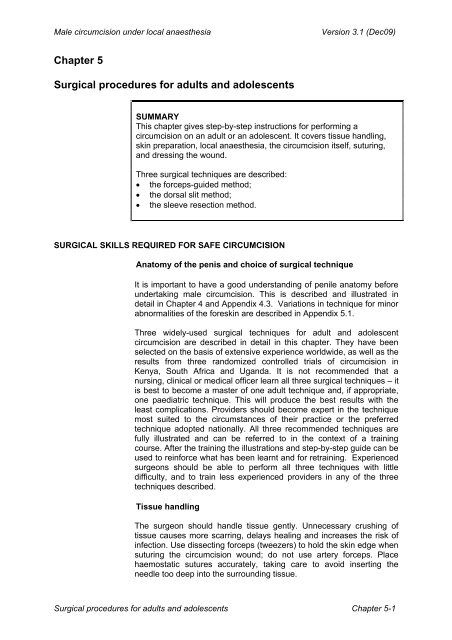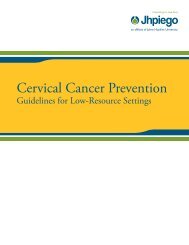Manual for Male Circumcision under Local Anaesthesia
Manual for Male Circumcision under Local Anaesthesia
Manual for Male Circumcision under Local Anaesthesia
Create successful ePaper yourself
Turn your PDF publications into a flip-book with our unique Google optimized e-Paper software.
<strong>Male</strong> circumcision <strong>under</strong> local anaesthesia<br />
Version 3.1 (Dec09)<br />
Chapter 5<br />
Surgical procedures <strong>for</strong> adults and adolescents<br />
SUMMARY<br />
This chapter gives step-by-step instructions <strong>for</strong> per<strong>for</strong>ming a<br />
circumcision on an adult or an adolescent. It covers tissue handling,<br />
skin preparation, local anaesthesia, the circumcision itself, suturing,<br />
and dressing the wound.<br />
Three surgical techniques are described:<br />
• the <strong>for</strong>ceps-guided method;<br />
• the dorsal slit method;<br />
• the sleeve resection method.<br />
SURGICAL SKILLS REQUIRED FOR SAFE CIRCUMCISION<br />
Anatomy of the penis and choice of surgical technique<br />
It is important to have a good <strong>under</strong>standing of penile anatomy be<strong>for</strong>e<br />
<strong>under</strong>taking male circumcision. This is described and illustrated in<br />
detail in Chapter 4 and Appendix 4.3. Variations in technique <strong>for</strong> minor<br />
abnormalities of the <strong>for</strong>eskin are described in Appendix 5.1.<br />
Three widely-used surgical techniques <strong>for</strong> adult and adolescent<br />
circumcision are described in detail in this chapter. They have been<br />
selected on the basis of extensive experience worldwide, as well as the<br />
results from three randomized controlled trials of circumcision in<br />
Kenya, South Africa and Uganda. It is not recommended that a<br />
nursing, clinical or medical officer learn all three surgical techniques – it<br />
is best to become a master of one adult technique and, if appropriate,<br />
one paediatric technique. This will produce the best results with the<br />
least complications. Providers should become expert in the technique<br />
most suited to the circumstances of their practice or the preferred<br />
technique adopted nationally. All three recommended techniques are<br />
fully illustrated and can be referred to in the context of a training<br />
course. After the training the illustrations and step-by-step guide can be<br />
used to rein<strong>for</strong>ce what has been learnt and <strong>for</strong> retraining. Experienced<br />
surgeons should be able to per<strong>for</strong>m all three techniques with little<br />
difficulty, and to train less experienced providers in any of the three<br />
techniques described.<br />
Tissue handling<br />
The surgeon should handle tissue gently. Unnecessary crushing of<br />
tissue causes more scarring, delays healing and increases the risk of<br />
infection. Use dissecting <strong>for</strong>ceps (tweezers) to hold the skin edge when<br />
suturing the circumcision wound; do not use artery <strong>for</strong>ceps. Place<br />
haemostatic sutures accurately, taking care to avoid inserting the<br />
needle too deep into the surrounding tissue.<br />
Surgical procedures <strong>for</strong> adults and adolescents Chapter 5-1
















